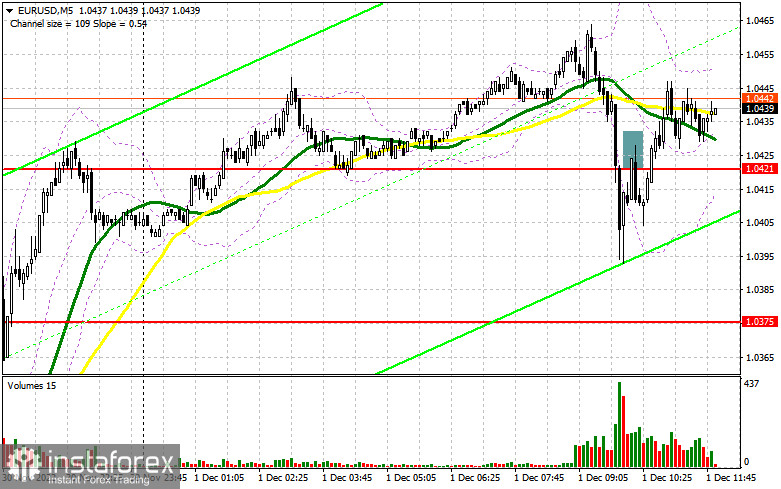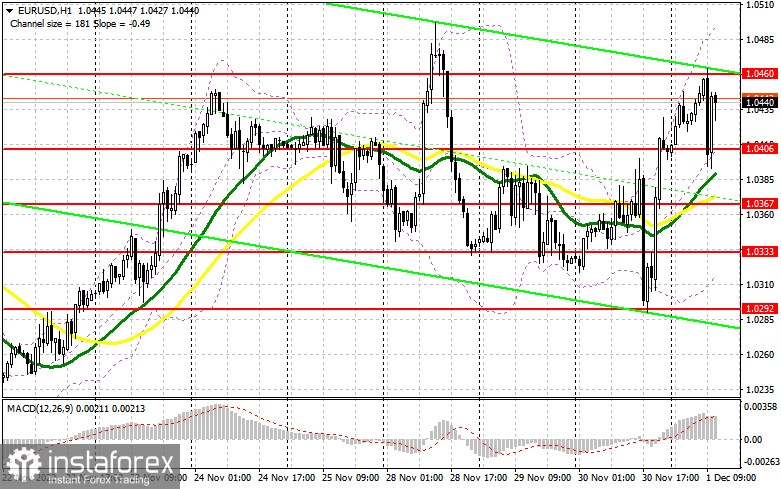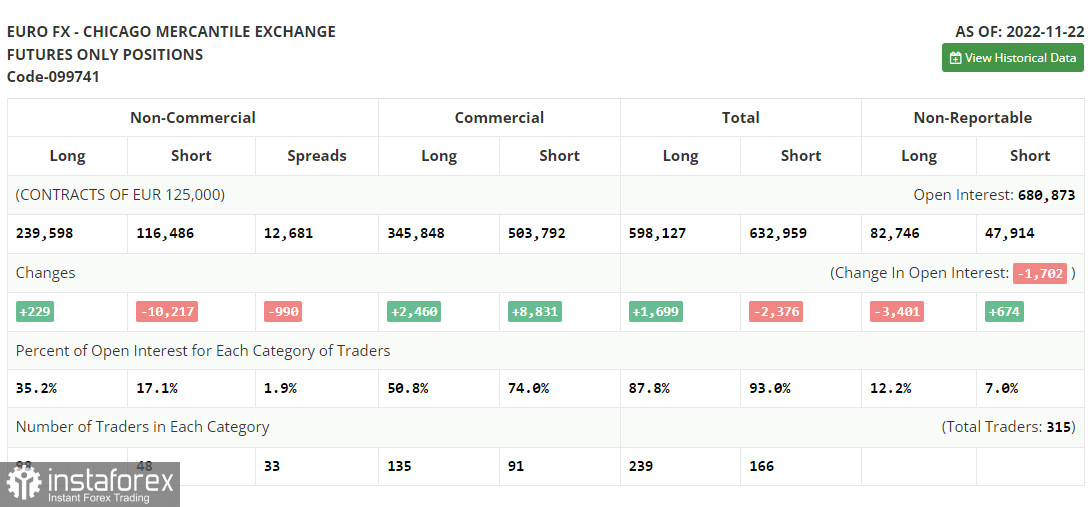In my morning review, I mentioned the level of 1.0421 and recommended entering the market from there. Let's see what happened on the 5-minute chart. As the euro fell amid downbeat PMI data for November, the euro/dollar pair broke through the level of 1.0421 and retested it. This created a sell signal. Unfortunately, the pair failed to develop a proper downtrend, so traders has to close their positions with losses. The technical setup has been revised for the second half of the day.

For long positions on EUR/USD:
Even though the discouraging data from the eurozone has limited the upside potential of the euro, the bulls seized the moment and won back all the losses, thus restoring the market balance. Let's see how the market will behave when the US data is out. The main reports this time will be the weekly data on initial jobless claims and the personal consumption index. In case of a decline, the demand for USD might come back but with low chances of a strong sell-off. The ISM manufacturing index, which is expected to be below the forecast, may undermine the position of the greenback holders. For this reason, I recommend buying the euro when it falls. Just make sure that the levels stay the same. If the euro declines, traders should focus on the nearest support of 1.0406. Its false breakout will generate a buy signal and will help the pair retest the 1.0460 level that was formed in the European session. A breakout of this range and its downward retest that was failed by the bulls in the early trade will reinforce the bullish bias and will pave the way towards 1.0513. If the price settles above this range, it may then develop a rise to the new monthly highs of 1.0568 and 1.0604 where I recommend profit taking. If EUR/USD declines in the New York session and buyers are idle at 1.03406, traders will start taking profit at the end of the month, thus putting more pressure on the euro. This is especially true in the case Jerome Powell's comments become less hawkish. If so, only a false breakout at the next support of 1.0367 will be a reason to buy the pair. Going long on EUR/USD right after a rebound is advisable only at the level of 1.0333 or at the low of 1.0292, keeping in mind a possible upside correction of 30–35 pips within the day.
For short positions on EUR/USD:
The best moment to sell the pair in the second half of the day will be a false breakout at 1.0460. The pair may test this level at the moment when the fundamental data is published in the US, given that the results are discouraging. This will create another entry point and will provoke a decline in the euro to the nearest support of 1.0406. Consolidation near this range and its upward retest will create an additional sell signal with triggered stop-loss orders set by the bulls. In this case, the euro may drop to 1.0367 where I recommend profit taking. The level of 1.0333 will serve as the lowest target. If EUR/USD moves up in the US trade and bears are idle at 1.0460, speculative sellers will start leaving the market. Such a scenario is very likely today as buyers of risk assets were encouraged by Jerome Powell's statement yesterday. This will reinforce the bullish presence and will help them resume the uptrend by opening the way to 1.0513. Selling at 1.0513 can be done only after a false breakout. Going short on EUR/USD right after a rebound is advisable only from the high of 1.0568, bearing in mind a downward correction of 30–35 pips within the day.

COT report
The Commitments of Traders report for November 22 recorded a rise in long positions and a sharp drop in short ones. The statement made by the Fed officials allowed the euro bulls to gain ground in the market. It seems that traders hope that the US regulator will change its aggressive approach to monetary policy. The upcoming data on the US GDP and labor market will be a decisive factor to shape the sentiment of the market. The inflation report for November will complete the picture. A drop in the number of new jobs and a higher unemployment rate will weaken the position of the US dollar against risk assets, including the euro. Investors also need to carefully monitor statements made by Fed officials. If the stance of the US central bank becomes more hawkish, this will provoke more selling in the US dollar. The reason behind this is that a further rate hike will push the economy closer to a bigger recession. According to the COT report, long positions of the non-commercial group of traders rose by 229 to 239,598 while short positions dropped sharply by 10,217 to 116,486. Last week, the overall non-commercial net position increased to 123,112 from the previous reading of 112,666. This indicates that investors are taking advantage of a cheaper euro and continue to buy it even though it is holding above the parity level. They might also be accumulating long positions in hope that the pair will start to recover sooner or later. The weekly closing price declined to 1.0315 from 1.0390 a week ago.

Indicator signals:
Moving Averages
Trading above the 30- and 50-day moving averages indicates the dominance of the euro bulls.
Please note that the time period and levels of the moving averages are analyzed only for the H1 chart, which differs from the general definition of the classic daily moving averages on the D1 chart.
Bollinger Bands
In case of a decline, the lower band of the indicator at 1.0320 will serve as support.
Description of indicators:
• A moving average of a 50-day period determines the current trend by smoothing volatility and noise; marked in yellow on the chart;
• A moving average of a 30-day period determines the current trend by smoothing volatility and noise; marked in green on the chart;
• MACD Indicator (Moving Average Convergence/Divergence) Fast EMA with a 12-day period; Slow EMA with a 26-day period. SMA with a 9-day period;
• Bollinger Bands: 20-day period;
• Non-commercial traders are speculators such as individual traders, hedge funds, and large institutions who use the futures market for speculative purposes and meet certain requirements;
• Long non-commercial positions represent the total number of long positions opened by non-commercial traders;
• Short non-commercial positions represent the total number of short positions opened by non-commercial traders;
• The non-commercial net position is the difference between short and long positions of non-commercial traders.





















